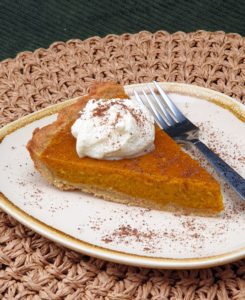Article updated 30 Sep 2019 Provide a spot or box with some straw and your hens will happily lay eggs it's that simple, jobs done – sad to say it isn't quite that simple.
After much trial and error, open-eyed surprises, shaking head disappointments, wasted money, wasted eggs, and lost time, I have evolved my chicken nesting/laying box system into one which finally works. Hence, if you want to know the truth about egg laying and nesting boxes please keep reading.
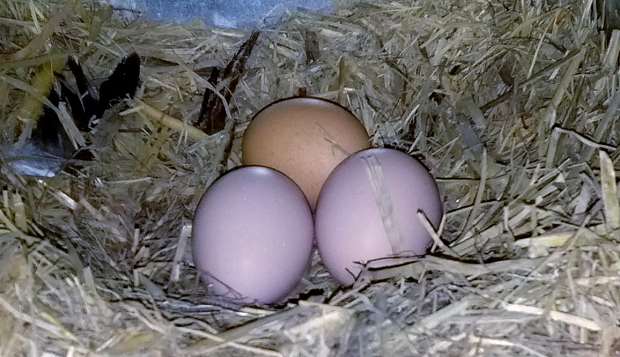
Clean eggs – yabba dabba dooo! (image above)
Nesting boxes or even a nesting area for chickens is often a consideration made by people after they have made the decision to get chickens. Before I started keeping chickens, like many, I did a lot of research about these delightful animals: what types of hens to get, how to house chickens, how to care for chickens, what chickens eat, how often do they lay, and the list goes on…
However, whilst I gathered all this information I never remember seeing anything specifically focused on nesting. Yes, there was the standard – “ensure you have a safe place for your chickens to nest and lay,” with the odd tip and image of a nesting box or area. Still, the complete flippancy online and in literature about nesting lead me to believe chickens and the act of laying (and where) was the least issue concerning chicken keepers.
Well, I soon found out the above sentence couldn't be further from the truth. Indeed, where chickens lay is one of the most important considerations for chicken keeping, particularly for the backyard or hobby-farmer. And, to be totally honest, the simple act of a hen doing her business took me a few years to properly figure out.
Not that chicken keeping is rocket science – they're actually a really easy animal to keep – but when I started seriously keeping chickens (and breeding them) I realised how individualistic hens can be with their own little "personalities." It's these different traits in some birds that make chicken keeping interesting and I suppose challenging if you get one or two that would rather roost overnight in a nesting box instead of the rail provided.
Chickens roosting in nesting boxes

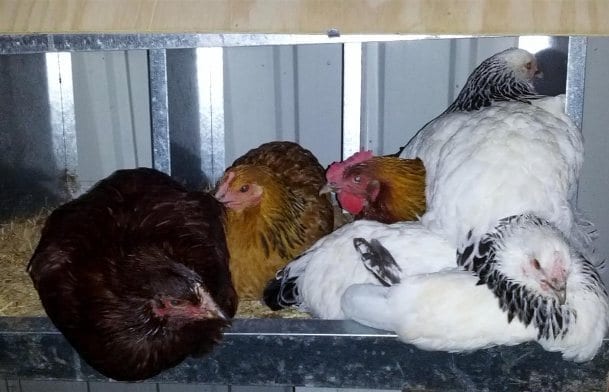
Hens all close and cozy roosting in nesting boxes (above)
Therefore, this article also covers how to manage (not stop) chickens roosting in nesting/laying boxes. For most backyard or hobby chicken enthusiasts, hens roosting in the nesting boxes is a fact of life and completely normal behaviour. In my flock, over the years, I've observed that many chickens like to sleep in the nesting/laying boxes.
To confuse the matter, not all chickens like to sit in a nesting box overnight and some (probably most) actually prefer to roost on a perch. And, chickens lower in the pecking order may be forced to use the perch if there isn't enough nesting boxes for every bird – that isn't necessarily cruel or a problem as both roosting areas are fine; therefore, I've come to the conclusion that BOTH types of roosting methods should be provided.
Often, I will find several hens squashed into one nesting box – it does look a bit comical but it does them no harm. The next night I might find two or three hens using the perches instead – it varies.

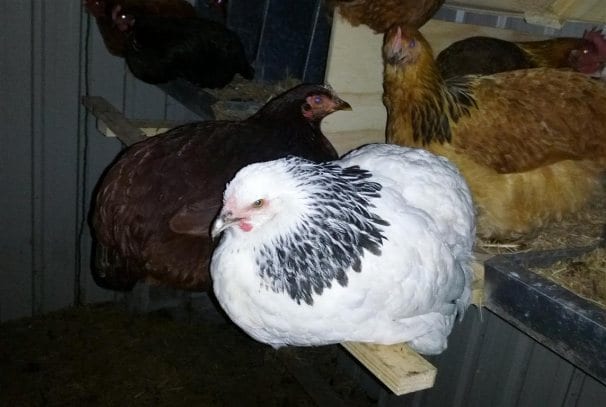
Hens roosting on perch in front of nesting boxes (above)
But the point I want to stress is, don't believe all the junk out there about hens roosting in nesting boxes as a behaviour needed to be stopped because it will drive you absolutely nuts trying to stop chickens from kipping in nesting boxes through the night. I've found over the years, different flocks tend to have different habits and can even change roosting/nesting behaviour over time.
Besides the standard roosting rail I have on the front of my nesting areas, I also have a lower roosting rail about a foot off the ground, which some hens (not many) prefer. And for the past few years (as at the latest edit of this article) we've provided several more perches (a tiered configuration) with most birds in our current flock preferring these and only one or two birds staying in the nesting boxes. At the end of the day, I'm not convinced that there's a perfect solution to keeping all hens out of the nesting boxes thus keeping the egg laying area perfectly clean – it's not possible in my opinion.
Nevertheless, our eggs are usually collected nice and clean and are only soiled on rare occasions or in wet weather when the chickens accidently drag in mud. What I have found over the years is hens will often do their best to keep the eggs clean and they will often lay in clutches or groups in one or two boxes rather than spread the eggs out even if there are numerous boxes spare.
Egg collecting
Having said that, I wish I could say egg collecting was as easy as how it's portrayed in lifestyle or how-to TV shows with the perfect clean egg sitting in the nice clean straw but unfortunately it isn't always like that.

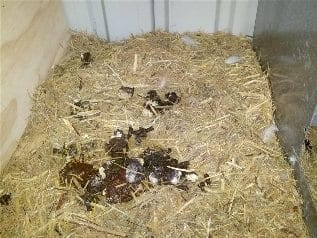
The actual egg comes out clean during the laying process but it's the poop it touches after, which makes the egg dirty. Also, as stated earlier, eggs can get dirty from dirt or mud especially in wet weather when the chickens come in to lay with muddy feet and inadvertently soil the nest or step on the eggs.
Mind you, most chickens will try to keep the eggs clean and often they will lay in the cleanest nesting box they can find. Hens will likely clean the nest (as best they can) before laying and sometimes even move eggs to a better spot within the box.
However, there’s only so much a chicken can do sanitary wise, so it's up to us to ensure the nesting boxes and materials within are kept as clean as reasonably possible. This means daily trips to the coop or preferably several quick trips a day. If only one trip a day is practical for you then a trip in the afternoon will ensure most of the egg laying has been completed so eggs aren’t sitting in the nest overnight.
Optimally, a visit in the morning and afternoon is the best because the morning trip can “re-set” the nesting boxes from the previous nights roosting by giving them a quick clean before the laying begins and the afternoon trip can collect the eggs.
By the way, it isn't uncommon for smaller flocks to all only use one nesting box for laying. And if after all the best planning and effort, a few eggs still get a little poopy, don't worry, just carefully wipe them clean with a dry cloth or rub off the dried manure with a light grade sand paper – don't wash with water or wipe them with a wet cloth because eggs are porous and the act of washing may leach bacteria through the shell and into the egg. If an egg is heavily soiled then discard it or give it to the dog (which is what I do).
Cleaning chicken nesting boxes

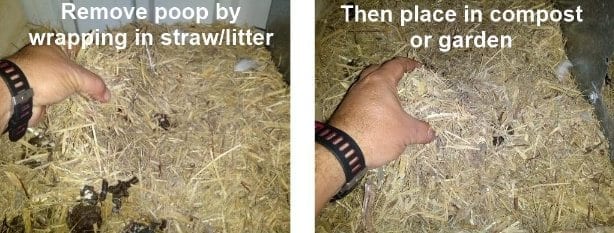
Cleaning a nesting box is simple, easy, and effective, provided it is done regularly. The best way to do this is by inspecting the laying boxes in the morning and removing the poop piles produced f
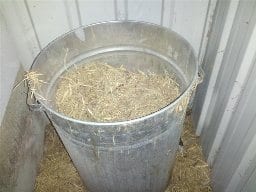
Once a month, I remove all the litter from the boxes and give them a good brush out then a dusting with a mite powder before placing more fresh litter back in.
I have a galvanised bin with replacement litter situated next to the nesting boxes so I can immediately top-up the nesting boxes once I'm done.
Types of laying boxes for chickens
When chickens need to lay they will practically lay anywhere if they have to but of course it's best to provide a comfortable, safe place for them to nest and lay. The following are some different types of nesting/laying boxes for hens:

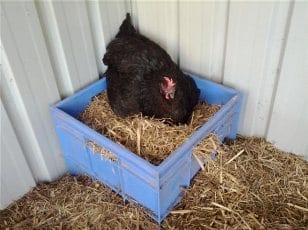
Open nesting boxes are particularly good for chickens that can't flap up to higher nesting boxes (breeds like silkies).
Drawbacks for open nesting: Tend to be close to the ground meaning more bending over to clean and collect eggs. More susceptible to predators like snakes, lizards, dogs and other animals.
Standard nesting boxes – A bit like open box shape shelving you might find in a house or shed. Normally, the boxes are about 1-2 feet high and wide and about the same deep forming a cube. A steep sloping roof on the nesting box is required (unless there's no space above it) otherwise the hens will also roost on top of the boxes and dirty them.


Standard nesting boxes are usually fixed to a wall or secured on a stand in a barn or chook shed with access gained from inside, although, access to nesting boxes from the outside can be built if required. Either DIY or commercial nesting boxes are good with DIY being the cheapest option and not that hard to do really. All that is required for basic nesting boxes are some cheap ply wood (some 10 and 4 mil pieces), a qty of timber off-cuts (pine will do), some wood glue, and wood screws.
Commercial nesting boxes can be simple too and sometimes hobby farm retailers make their own basic boxes for reasonable prices. You can also get very elaborate nesting box designs like igloo boxes with insulation or accessories and pretty designer boxes all different colours if you have the money to spend.
Drawbacks for standard nesting boxes – None really, although cost can be restrictive if buying the commercial boxes.

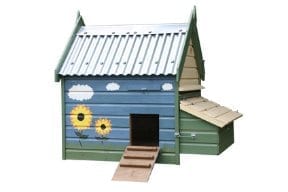
Drawbacks for contained nesting boxes – With exception to the larger walk-in barn types of contained nesting boxes, the urban designs (including mobile chicken tractors) can become a little overcrowded and messy when the flock passes half dozen. Also, cleaning inside the boxes and immediate housing can be difficult.

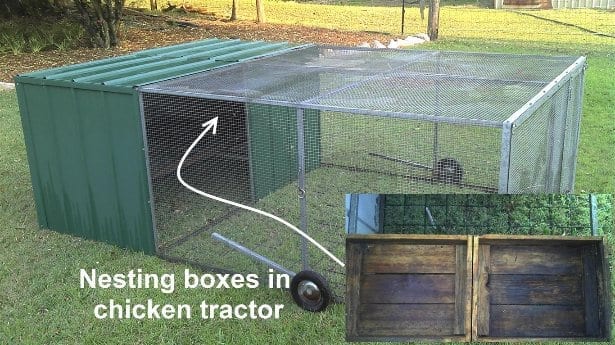
Roll-away – A nesting box set-up where the egg rolls into a collection area either at the rear or front of the box. Typically, plastic mesh inserts or special matting act as the nesting material on a slight gradient, which tunnels the egg to the collection area.
Roll away nesting boxes can be a handy method to overcome certain prob
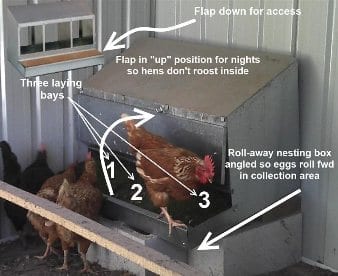
Hens seem to be fine with the plastic inserts and tend to happily sit on them to lay.
DIY roll-away nesting boxes are also easy enough to make. The plastic nest inserts can be purchased separately (without the box) and the nesting box can be home made saving considerable costs.
Drawbacks for roll-away nesting boxes – I have my own prejudices when it comes to roll-away nesting boxes and whilst I acknowledge the system does work for some people, I personally don't recommend roll-away nesting boxes for backyard chicken keeping. I have written more about why I'm not a fan of roll-away nesting boxes later in this article (myths section).
Pseudo nesting box – If you begin to notice missing eggs or the hens just don't seem to be laying much lately, then before blaming predators, egg eating hens, stealing neighbours, chicken diet etc for the puzzling egg shortage, firstly, do a walk around to check the hens don't have a secret laying spot.


I once had a hen with a odd fetish for laying in my garden shed under my tool rack where I kept my shovels and garden forks. Nearly every day she would leave the rest of the flock and trundle up 70 metres to the shed when it was egg laying time. Another hen would lay in the compost heap until I decided to only let the girls out of the hen enclosure after laying was done (usually after lunch).
Pseudo nesting spots can be particularly evident for large backyards where chickens are allowed to free-range and occasionally the hens will find a better spot than what we've provided to lay, like a tree hollow or under a shrub (or a tool rack). If this happens blocking access (even temporarily) should get them laying back in the nesting boxes provided .
Open nests only attract predators and scavengers like snakes and crows so it's usually prudent to nip it in the bud quickly.
Myths about laying boxes for chickens
Myth 1 – Perch height
Keep the nesting/laying boxes lower than the perches because chickens like to roost on the highest spot – then they won't roost in the boxes .

I have never seen any evidence to support this notion. I believe it's a complete myth. Not withstanding the fact this technique doesn't work to encourage hens to roost on the perch instead of in the laying box through the night; but also, laying boxes lower and closer to the ground are: more susceptible to predators, and harder to get to for egg collection.
Unless the hens are soft feathered (silkies, for instance) the nesting boxes should be at least above waist high. If the hens are soft feathered and can't fly too well then closer to the ground it has to be; although, I'd look at creating a step or ramp first to see if the girls can't be helped jump-up a little higher.
Myth 2 – Screening off nesting boxes or area
A screen in front of the nesting boxes will stop chickens roosting in them at night.
Some claim chickens like privacy when laying but don't like being closed off when roosting; therefore, a screen in front of the nesting boxes (within a foot or so) will allow the hens to lay but deter them from sleeping in the nest at night. This doesn't work – I tried the screening method for months and noticed no change in behaviour.
Myth 3 – Roll away nesting boxes
Roll away nesting boxes are an easy way to keep the eggs clean, stop cannibalism (hens eating own eggs), and ensure eggs are safe from predators.
Not really. Ok, yes, they do work but are the benefits worth the effort and cost? I have to say in my experience, no.
In roll-away nesting box set-ups the inserts quickly get messy and covered in manure; therefore, inserts need to be regularly removed and washed for the system to be effective.

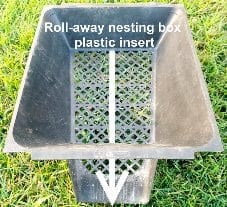
When I used the roll-away system (and paid handsomely for the boxes), I found the maintenance and effort involved to keep the inserts clean and collect the eggs was just not worth it. The type of retail roll-away nesting boxes I got did have the ability to block access to the hen so they couldn't roost in the box through the night by a galvanised flap; nevertheless, the practicality of remembering to put this flap up in the evening and down in the morning is self evident.
Commercially, roll away nesting boxes work only because the birds are kept as battery hens in cages,
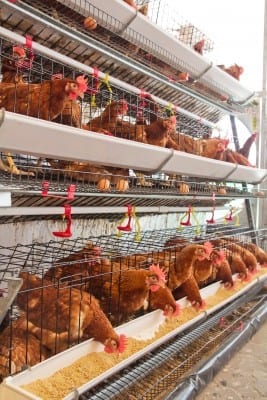
Furthermore, keeping the eggs clean via these commercial practices isn't 100% anyway, that's why they use egg cleaning machines which wash and spray the outer egg shells with disinfectant.
I no longer use the roll-away laying boxes (as designed) but to save costs I did modify the boxes and incorporate them into the system I have today.
Honestly, the standard nesting box method using a litter like straw or sugar cane mulch is more practical because, unlike a plastic insert, the litter helps absorb the manure somewhat which can actually help keep the eggs cleaner. Whereas, only one poop on a plastic insert is needed to dirty any eggs laid after until the insert is removed and cleaned.
How many nesting boxes?
One nesting box per 4 hens is usually the minimum rate for conventional set-ups. However, I believe in striving for a ratio of 1:1 if the nesting/laying boxes are considered “roosting” boxes also. If the nesting boxes are large enough often hens will roost together – this is the case in my set-up; therefore, 1:1 probably isn't necessary.
My laying/nesting/roosting boxes set-up
My chickens are housed in a large open roofed compound; therefore, I need to be mindful of egg predators that can fly or climb into the coop and gain access to the nesting boxes (predators like crows, and goanna).
So what do I use? After trying every method possible I prefer to have my hens lay in a standard type nesting box set-up and I don't restrict the chickens access at all if they want to roost in them through the night, in fact, I encourage it. 



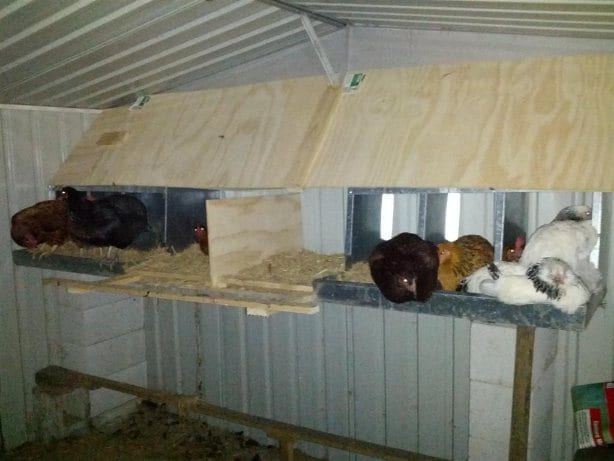
Nesting box set-up with chickens roosting at night (above)
I have ensured there are enough nesting boxes (or space within) to easily accommodate all my hens if they decide to all roost at the same time.
My nesting boxes are a DIY job made from standard pine and ply wood combined with the roll-away nesting boxes, which I modified by removing the front galvanised flaps/hinges and turned them into standard boxes. The centre divider in my wooden boxes is removable by sliding out for easy cleaning. I have incorporated a perch in the centre of the nesting boxes as an alternative roost for the birds and also as an easy entry point for them to jump up and gain access to the boxes.

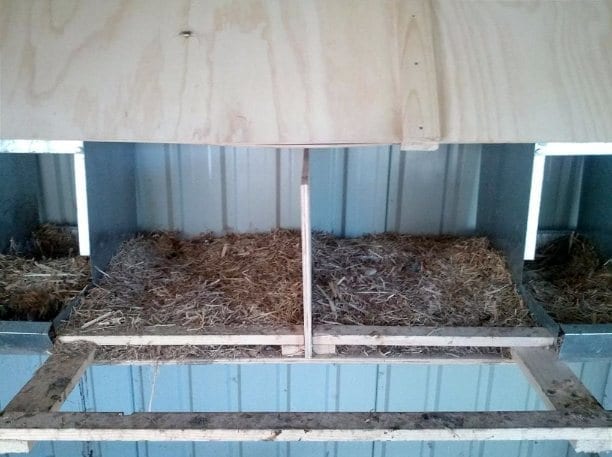
DIY nesting boxes with front perch & gap in wood at front of box makes for easy sweep out (image above)
The nesting boxes are situated at the back of the coop and off the ground about 1.5 metres high and are secured (by screws) to a stand made from a pine sleeper and Besser blocks. Due to an egg predator problem I have called the Australian goanna, the nesting boxes overhang the stand making it impossible for the lizard to climb up and reach the eggs – the shed being aluminium means the walls can't be climbed either. I have also secured the boxes to the wall for extra stability and made a simple angle cover from thin ply wood to prevent roosting on top of the boxes.

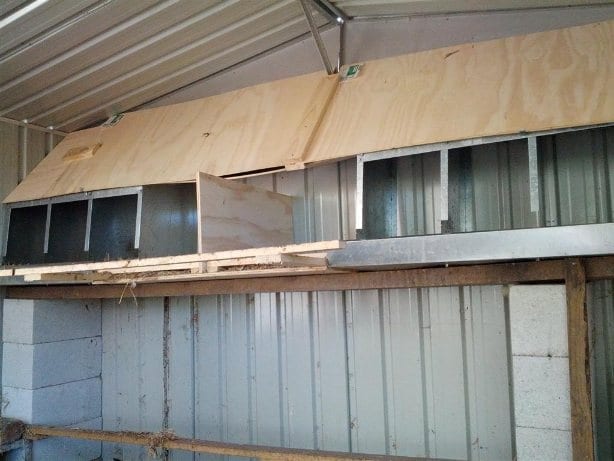
Underside of nesting boxes showing the brick and sleeper stand (image above)
This system, as simple as it is, works well and as long as the soiled litter is scooped out and replaced daily the eggs remain clean (mostly).
Since writing this article, I have modified my nesting boxes by fitting a galvanised lip on the front to prevent hens from raking the nesting material out. This behaviour seemed to begin out of the blue and quickly turned into a bad habit. Anyway, I have made a video about this modification at the end of this article so just scroll down if you'd like to see it.
Conclusion
My nesting box set-up may not be everyone’s cup of tea and that's fine. Whether the nesting/laying system employed is the roll-away, a simple open box type using an old tyre, or a similar method to m
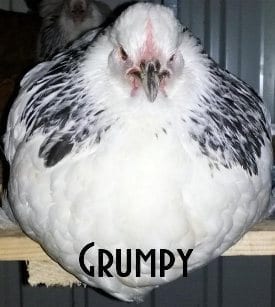
I hope by elaborating on the different nesting box systems this article has given a better insight into what's often an overlooked consideration when people are planning to get into chicken keeping. And, possibly by reading this article choosing a nesting box system will be made easier thus saving unnecessary costs later down the track.
Why not have your say? Do you have a question about nesting boxes or perhaps an idea you'd like to share with the readers? Join our forum (it's free) and we have a great little chicken section to browse. You can also leave a comment below in the comments section – your email is not required to be entered.
Some useful links for chicken nesting boxes
eBay Australia (a little bit limited on stock)
eBay USA (good variety of nesting boxes)
Amazon USA (heaps of nesting boxes)
Amazon UK (good selection of nesting boxes)
Video on stopping hens raking material out of nesting boxes
https://www.youtube.com/watch?v=sngle_E2vd8&t=1sThanks for reading and thanks for your support.
Look, and see the Earth through her eyes
Mark Valencia – Editor SSM












